#international eucharistic congress
Text



Princess Grace and Prince Rainier attend with their children attend with Major Rizzo and his wife to the opening of the International Eucharistic Congress at the Cathedral of SS. Peter and Paul in Philadelphia, PA, on August 1, 1976.
4 notes
·
View notes
Text
Events 6.20 (before 1945)
451 – Battle of Chalons: Flavius Aetius' battles Attila the Hun. After the battle, which was inconclusive, Attila retreats, causing the Romans to interpret it as a victory.
1180 – First Battle of Uji, starting the Genpei War in Japan.
1622 – The Battle of Höchst takes place during the Thirty Years' War.
1631 – The Sack of Baltimore: The Irish village of Baltimore is attacked by Barbary slave traders.
1652 – Tarhoncu Ahmed Pasha is appointed Grand Vizier of the Ottoman Empire.
1685 – Monmouth Rebellion: James Scott, 1st Duke of Monmouth declares himself King of England at Bridgwater.
1756 – A British garrison is imprisoned in the Black Hole of Calcutta.
1782 – The U.S. Congress adopts the Great Seal of the United States.
1787 – Oliver Ellsworth moves at the Federal Convention to call the government the 'United States'.
1789 – Deputies of the French Third Estate take the Tennis Court Oath.
1791 – King Louis XVI, disguised as a valet, and the French royal family attempt to flee Paris during the French Revolution.
1819 – The U.S. vessel SS Savannah arrives at Liverpool, United Kingdom. It is the first steam-propelled vessel to cross the Atlantic, although most of the journey is made under sail.
1837 – King William IV dies, and is succeeded by his niece, Victoria.
1840 – Samuel Morse receives the patent for the telegraph.
1862 – Barbu Catargiu, the Prime Minister of Romania, is assassinated.
1863 – American Civil War: West Virginia is admitted as the 35th U.S. state.
1877 – Alexander Graham Bell installs the world's first commercial telephone service in Hamilton, Ontario, Canada.
1893 – Lizzie Borden is acquitted of the murders of her father and stepmother.
1895 – The Kiel Canal, crossing the base of the Jutland peninsula and the busiest artificial waterway in the world, is officially opened.
1900 – Boxer Rebellion: The Imperial Chinese Army begins a 55-day siege of the Legation Quarter in Beijing, China.
1900 – Baron Eduard Toll, leader of the Russian Polar Expedition of 1900, departs Saint Petersburg in Russia on the explorer ship Zarya, never to return.
1921 – Workers of Buckingham and Carnatic Mills in the city of Chennai, India, begin a four-month strike.
1926 – The 28th International Eucharistic Congress begins in Chicago, with over 250,000 spectators attending the opening procession.
1942 – The Holocaust: Kazimierz Piechowski and three others, dressed as members of the SS-Totenkopfverbände, steal an SS staff car and escape from the Auschwitz concentration camp.
1943 – The Detroit race riot breaks out and continues for three more days.
1943 – World War II: The Royal Air Force launches Operation Bellicose, the first shuttle bombing raid of the war. Avro Lancaster bombers damage the V-2 rocket production facilities at the Zeppelin Works while en route to an air base in Algeria.
1944 – World War II: The Battle of the Philippine Sea concludes with a decisive U.S. naval victory. The lopsided naval air battle is also known as the "Great Marianas Turkey Shoot".
1944 – World War II: During the Continuation War, the Soviet Union demands unconditional surrender from Finland during the beginning of partially successful Vyborg–Petrozavodsk Offensive. The Finnish government refuses.
1944 – The experimental MW 18014 V-2 rocket reaches an altitude of 176 km, becoming the first man-made object to reach outer space.
0 notes
Text
Catalysts of Change: CCAS celebrates first commencement exercises
Normalites from the College of Culture, Arts, and Sports (CCAS) finally yielded their years of hard work in their first Commencement Exercises held last June 3, at the International Eucharistic Congress Convention Center of Cebu (IC3).
Msgr. Joseph Tan presided over the Baccalaureate Mass, accompanied by the Cebu Normal University (CNU) Chorale, before welcoming the graduates in the academic…

View On WordPress
0 notes
Text
Reflection: Our Disabilities as Gift from God
One of my memorable experiences was to meet Fr. Cyril Axelrod at the International Eucharistic Congress in Cebu City in 2016. Father Cyril is a South African Catholic priest who is deaf and blind. It was a wonder that I was able to communicate with him in one of the free and spontaneous moments at the Congress. I wondered how I could communicate with him. If I spoke, he would not be able to hear; and how would he speak to me if he could neither see nor hear nor speak? There was an interpreter who held his hands and did sign language as I asked him, “How many years as a priest? What do you think about this Congress?” And he answered these questions of mine and others—he used sign language and the interpreter relayed to me Father Cyril’s thoughts.
Father Cyril was born deaf to Jewish parents. He became Catholic and professed as a Redemptorist and was ordained priest. Thus, he had been able to say Mass for the deaf. Later, he became blind, but even in that state, he continued his ministry to help the disabled. He has inspired so many people. Gunther Simmermacher, a writer, had this to say about Father Cyril: “His fingers and hands are his eyes, mouth, and ears. Father Cyril Axelrod is deaf and blind, so he talks, hears, and sees with his hands. The Johannesburg-born priest . . . sees his disability as ‘a gift from God.’”
I remember Father Cyril as I read about the blind man who kept calling out to Jesus. Of course, the man in the Gospel episode today is not deaf, and Father Cyril was not cured of these physical illnesses. But their point of convergence is Jesus who was present, their faith and zeal, and their following Jesus and giving glory to God. My meeting with Father Cyril shook me and reminded me that my own defects and weaknesses should not deter me from calling on the Lord and following Him.
~Fr. Joel Camaya, SDB
What are your defects, weaknesses, or even disabilities? Does the presence of Jesus bring you to greater faith despite these weaknesses?
Lord, please let me see so that I may follow You and give You glory. Amen.
Prayer
… for a deep and profound respect for life, especially for the unborn.
… for the strength and healing of the sick.
… for the healing and peace of all families.
Finally, we pray for one another, for those who have asked our prayers and for those who need our prayers the most.
GOD BLESS!
0 notes
Photo

ABOVE: IN HOTEL SUITE at The Barclay, the Rev. Joseph B. Graham and Mrs. Rosemary T. Callan give a silver paten to Prince Rainier III and Princess Grace. The plate commemorates the International Eucharistic Congress, which will open in Philadelphia on Aug. 1. Prince Rainier and Princess Grace will participate in the congress.
The Philadelphia Inquirer - July 12, 1976
Princess Grace, Prince Rainier host 300 at Bicentennial salute
By RUTH SELTZER
Monaco's Sovereign Prince Rainier III and his Philadelphia-born wife, Princess Grace, entertained 300 guests Friday at a cocktail reception at the Philadelphia Country Club in Gladwyne.
It was Monaco's Bicentennial salute to the United States and Philadelphia. It was a beautiful party.
Prince Rainier and Princess Grace welcomed guests. They stood in a receiving line with their three children, Princess Caroline, Prince Albert and Princess Stephanie. Princess Grace's brother, Councilman John B. Kelly Jr., was at the head of the line.
“Doesn't Grace look marvelous!" exclaimed one guest. "She never seems to look a year older!" said another.
Princess Grace wore a lovely white silk pajama ensemble.
There was an informality about the party - relaxed and very pleasant. Hors d'oeuvres - hot and cold - were served. A trio played background music.
We saw Princess Grace and Prince Rainier twice that day. Before going to the country club for the cocktail party, we attended a presentation ceremony in their honor.
At the ceremony, in a Barclay Hotel suite, the Rev. Joseph B. Graham presented a sterling silver paten - a plate for the eucharistic bread - to Prince Rainier and Princess Grace in recognition of the part they play "in Christian life throughout the world."
Father Graham is director of institutional services of the Archdiocese of Philadelphia. Prince Rainier and Princess Grace will participate in the 41st International Eucharistic Congress, which will open in Philadelphia on Aug. 1. On Aug. 2, Rainier and Grace will keynote the plenary session of an all-day conference on family life. The conference will be held at the Philadelphia Civic Center.
At Friday's presentation ceremony was Mrs. Rosemary T. Callan, board chairman of the C & B Corp. of Warminster, Bucks County. There, too, were Saul Lapp, president of the firm, and John Neville, who is also an official of C & B. That firm has produced commemorative silver plates (exactly the same as the one given to Prince Rainier and Princess Grace). The plates will be sold (at $300 each) to help underwrite the expenses of the Philadelphia Archdiocese in hosting the Eucharistic Congress here.
The first plate, number 1, will be presented to Pope Paul VI. It will be accepted in his behalf at the Eucharistic Congress by James Cardinal Knox of Australia, who has been appointed papal legate to the congress.
Silver plates will also be presented to President Ford, Archbishop Jadot (the apostolic delegate to the United States), and John Cardinal Krol, Archbishop of Philadelphia.
Cardinal Krol attended Monaco's party Friday at the country club. He arrived at the same time that we did. For several minutes, Cardinal Krol chatted with Princess Grace and Prince Rainier.
Mr. and Mrs. Richard C. Bond were at the party. He is board chairman of Philadelphia ‘76 Inc., the city's Bicentennial agency. There, too, were City Representative Albert V. Gaudiosi and his wife, Cecelia; Deputy City Representative Anna Marie O'Brien and her husband, John T. O'Brien; William L. Rafsky (executive director of Philadelphia ‘76 Inc.) and his wife, Selma.
Princess Grace's mother, Mrs. John B. Kelly, was at the party. So were Grace's sisters, Mrs. Donald Caldwell LeVine and Mrs. Margaret Kelly Conlan. We talked with Mrs. LeVine (Lizanne) and her husband, Don.
Several of Princess Grace's cousins were there. Mrs. E. Shirley Turner came up from Middleburg, Va., for the party. She is Grace's cousin, Jean.
Princess Grace's cousin, John Lehman, and his wife, Barbara, flew up from Washington for the party. He is deputy director of the U. S. Arms Control and Disarmament Agency.
Mayor and Mrs. Frank L. Rizzo were invited, as were Gov. and Mrs. Milton J. Shapp. They sent regrets.
At the party, we said hello to Fire Commissioner Joseph Rizzo and his wife, Marge (the mayor's brother and sister-in-law). Police Commissioner Joseph F. O'Neill and his wife, Eleanor, were there.
Curtis P. Laupheimer, who is Monaco's consul in Philadelphia, and his wife, Betty greeted guests. So did Alfred J. Laupheimer Jr. and his wife, Jenny. Alfred and Curtis are brothers. Alfred, who now lives in Delray Beach, Fla., is Monaco's consul in Florida.
Mr. and Mrs. Joseph S. Rambo were at the party. Mrs. Rambo (Maree) was Princess Grace's bridesmaid. The wedding in Monaco took place in April 1956. Three months before the wedding, the engagement of Miss Grace Kelly to Prince Rainier III was announced at a luncheon given by her parents, Mrs. John B. Kelly and the late Mr. Kelly, at the Philadelphia Country Club.
At Friday's party, in the same clubhouse, were Trenton banker Mary G. Roebling; Wanamaker president Robert Drew Harrison and Mrs. Harrison; William S. Cashel (president of Bell Telephone Company of Pennsylvania) and Mrs. Cashel; G. Morris Dorrance (board chairman of Philadelphia National Bank) and Mrs. Dorrance; Thacher Longstreth (president of the Greater Philadelphia Chamber of Commerce) and Mrs. Longstreth; Atlantic City Race Track president Robert P. Levy and Mrs. Levy; Philadelphia's City Council president George X. Schwartz and Mrs. Schwartz; Wilmington's Mayor Thomas C. Maloney and Mrs. Maloney.
The Rev. Dr. Leon Sullivan and Mrs. Sullivan were there. So were British Consul-General and Mrs. Denis Richards; Mr. and Mrs. George J. Hauptfuhrer Jr., Jules Lavin; Mrs. William T. Coleman Jr. (wife of the U. S. Secretary of Transportation) and her son, Bill; Mrs. Richard S. Schweiker (wife of the U. S. senator) and her son, Malcolm; Lennox Moak (the city's budget director) and his wife, Helen; U. S. District Judge and Mrs. A. Leon Higginbotham; U. S. District Judge and Mrs. John Morgan Davis; Mrs. Russell Austin; Mr. and Mrs. Clarence Farmer; Mr. and Mrs. John M. Seabrook; Tom Foglietta; Lt. Gen. and Mrs. Willard Pearson; Hillel Levinson (managing director of Philadelphia) and his bride, Caryl; Rear Adm. Wycliffe Toole Jr. (commandant of the Fourth Naval District) and Mrs. Toole; Mr. and Mrs. John Gribbel 2d; and Mr. and Mrs. James A. Nolen Jr.
Wharton Shober, president of Hahnemann Medical College and Hospital, was at the cocktail party. Earlier in the day, Mr. Shober gave a luncheon in Hahnemann's executive suite. Prince Albert, who is now 18, arrived with his uncle, Councilman Kelly. The luncheon, which we attended, was in honor of the U. S. Equestrian Team, on the eve of the team's departure for the 1976 Olympic Games. Prince Albert, heir to the throne of Monaco, presented a commemorative scroll to the team. The scroll, given on behalf of Hahnemann, was accepted by Jack LaGoff, the team's coach.
Last week in Philadelphia was summed up best by Marie Cashel, wife of the president of Bell Tel. Said she: "On Sunday, we went to a luncheon for the President of the United States. On Tuesday, we went to a dinner for the Queen of England. Today we are at a cocktail party given by the Prince and Princess of Monaco. Tomorrow, we'll get back to work in our garden."
#Princess Grace#Prince Rainier#Barclay Hotel#Philadelphia Country Club#International Eucharistic Congress#Ruth Seltzer#Philadelphia Inquirer#Philadelphia#1976#70s#newspaper article
19 notes
·
View notes
Text
Watch "Highlights of the International Eucharistic Congress | EWTN News In Depth" on YouTube
youtube
24 notes
·
View notes
Text
Monday, September 13, 2021
UN chief: World is at `pivotal moment’
(AP) U.N. Secretary-General Antonio Guterres issued a dire warning that the world is moving in the wrong direction and faces “a pivotal moment” where continuing business as usual could lead to a breakdown of global order and a future of perpetual crisis. Changing course could signal a breakthrough to a greener and safer future, he said. The U.N. chief said the world’s nations and people must reverse today’s dangerous trends and choose “the breakthrough scenario.” The world is under “enormous stress” on almost every front, he said, and the COVID-19 pandemic was a wake-up call demonstrating the failure of nations to come together and take joint decisions to help all people in the face of a global life-threatening emergency. Guterres said this “paralysis” extends far beyond COVID-19 to the failures to tackle the climate crisis and “our suicidal war on nature and the collapse of biodiversity,” the “unchecked inequality” undermining the cohesion of societies, and technology’s advances “without guard rails to protect us from its unforeseen consequences.” In other signs of a more chaotic and insecure world, he pointed to rising poverty, hunger and gender inequality after decades of decline, the extreme risk to human life and the planet from nuclear war and a climate breakdown, and the inequality, discrimination and injustice bringing people into the streets to protest.
World marks 20th anniversary of 9/11
(AP) The world solemnly marked the 20th anniversary of 9/11 on Saturday, remembering the dead, invoking the heroes and taking stock of the aftermath just weeks after the bloody end of the Afghanistan war that was launched in response to the terror attacks. Victims’ relatives and four U.S. presidents paid respects at the sites where hijacked planes killed nearly 3,000 people in the deadliest act of terrorism on American soil. Others gathered for observances from Portland, Maine, to Guam, or for volunteer projects on what has become a day of service in the U.S. Foreign leaders expressed sympathy over an attack that happened in the U.S. but claimed victims from more than 90 countries.
Phony diagnoses are hiding high rates of drugging at nursing homes
(NYT) The risks to patients treated with antipsychotics—which understaffed nursing homes have often used as “chemical straitjackets”—are so high that nursing homes must report to the government how many of their residents are on these potent medications. But there is an important caveat: The government doesn’t publicly divulge the use of antipsychotics given to residents with schizophrenia or two other conditions. A Times investigation found a pattern of questionable schizophrenia diagnoses nationwide. The result: The government and the industry are obscuring the true rate of antipsychotic drug use on vulnerable residents. The share of residents with a schizophrenia diagnosis has increased to 11 percent from less than 7 percent since 2012. At least 21 percent of nursing home residents are on antipsychotic drugs.
Tropical Storm Nicholas forms in Gulf of Mexico
(AP) Tropical Storm Nicholas strengthened as it headed for the Gulf Coast on Sunday, threatening heavy rain and floods in coastal areas of Texas, Mexico and Louisiana. Forecasters at the National Hurricane Center in Miami said tropical storm warnings were issued for coastal Texas and the northeast coast of Mexico. Nicholas is expected to produce total rainfall of 5 to 10 inches (13 to 25 centimeters), with isolated maximum amounts of 15 inches, across portions of coastal Texas into southwest Louisiana on Sunday through midweek. The storm was expected to bring the heaviest rainfall west of where Hurricane Ida slammed into Louisiana two weeks ago.
Britain decides against vaccine passports
(AP) Britain’s health secretary said Sunday that authorities have decided not to require vaccine passports for entry into nightclubs and other crowded events in England, reversing course amid opposition from some of the Conservative government’s supporters in Parliament. Sajid Javid said the government has shelved the idea of vaccine passports for now but could reconsider the decision if COVID-19 cases rise exponentially once again. The U-turn came just days after the government’s vaccines minister and the culture secretary suggested that vaccine passports would still be necessary, despite growing opposition from lawmakers. Such passports are required in other European countries, like France. Members of the governing Conservative Party have objected to such passports as an unacceptable burden on businesses and an infringement on residents’ human rights.
Thousands of Catalans rally for independence in Barcelona
(Reuters) Thousands of Catalans chanted, sang and waved flags as they marched through Barcelona on Saturday, calling for the region’s independence from Spain. The march, organised by the grassroots Assemblea Nacional Catalana ANC, was the first since Spain’s government pardoned nine Catalan separatist leaders who had been jailed for their role in a 2017 botched bid for independence, which was Spain’s biggest political crisis in decades. Most marchers wore face coverings. Police said about 108,000 people took part. ANC put the figure close to 400,000. The protests took place at a moment of lower tension between Barcelona and Madrid than in past years as the central and regional governments favour dialogue despite their opposing views on independence.
In Hungary, pope meets PM Orban, his political opposite
(Reuters) Pope Francis arrived in Hungary early on Sunday, starting an unusually short stay that underlines differences with his political opposite, nationalist and anti-immigrant Prime Minister Viktor Orban. Francis, 84, who is spending only seven hours in the capital Budapest, went directly from the airport to a private meeting with Orban and President Janos Ader in the Museum of Fine Arts. Unlike nearly every other papal trip, there was no live television coverage of the preliminary greetings or the photo opportunities that usually precede and follow such meetings. The pope is making the brief Budapest stop to say a Mass closing an international Roman Catholic meeting, known as an International Eucharist Congress. On Sunday afternoon he moves on to Slovakia, where he will stay much longer, visiting four cities before returning to Rome on Wednesday.
Nine-cent taxi rides in rural South Korea are a “godsend.”
(NYT) In 2013, Seocheon County faced a crisis. As its population declined, so did the number of bus passengers, which led to unprofitable routes being canceled, stranding those in remote hamlets who did not own cars. The county’s solution? The 100-won taxi. (Longer routes cost 1,500 won, or about $1.30.) Anyone whose hamlet is more than 2,300 feet from a bus stop can call one, and the county picks up the rest of the fare. The taxis carried nearly 40,000 passengers last year, which cost the county $147,000. Since the 100-won taxi was introduced, people in remote villages have traveled outside twice as often, according to a government survey. More than 2.7 million passengers used similar taxi services in rural South Korea last year.
Strong typhoon cuts power, causes flooding in northern Philippines
(Reuters) Several communities remain flooded and without power after a strong typhoon battered the Philippines’ northernmost islands, the authorities said on Sunday, displacing thousands of people. Typhoon Chanthu, which at one point was categorised by the Philippine weather bureau as a category 5 storm, has weakened after powering into the northernmost region, including the Batanes island group, on Saturday, the weather bureau said. “It’s one of the strongest typhoons I’ve felt,” said Dennis Ballesteros Valdez, a resident of Sabtang town in the province of Batanes, which is often pummelled by powerful typhoons. Some 20 typhoons hit the Philippines on average each year, according to the weather authorities.
Taliban flag rises over seat of power on fateful anniversary
(AP) The Taliban raised their flag over the Afghan presidential palace Saturday, a spokesman said, as the U.S. and the world marked the 20th anniversary of the Sept. 11 attacks. The white banner, emblazoned with a Quranic verse, was hoisted by Mullah Mohammad Hassan Akhund, the prime minister of the Taliban interim government, in a low-key ceremony. In a tweet, Afghanistan’s first president to follow the 2001 collapse of the Taliban, Hamid Karzai, called for “peace and stability” and expressed the hope that the new caretaker Cabinet that included no women and no non-Taliban would become an “inclusive government that can be the real face of the whole Afghanistan.”
Death and suffering in Iraq a painful legacy of 9/11 attacks
(AP) Iraq had nothing to do with 9/11. But the terrorist attacks in the United States changed forever the lives of Iraqis. In their aftermath, the U.S. invaded Afghanistan, swiftly deposing the Taliban regime that had been sheltering Osama bin Laden, the leader of the al-Qaida terror network blamed for the attacks. But it was not long before President George W. Bush shifted his attention to Iraq, identifying it, along with Iran and North Korea, as part of an “axis of evil” and asserting that its brutal dictator, Saddam Hussein, was armed with weapons of mass destruction and had ties to al-Qaida. No evidence of either was found. What followed was a U.S.-led invasion of a country in the heart of the Middle East that spurred a decade of war, with consequences that reverberate across the region to this day. After decades of conflict, Iraq today has a relatively stable government, and the car bombings, suicide attacks and death squads have subsided. But the economy is in tatters, its infrastructure is crumbling and corruption is rampant. The government, with its fractious politics, is unable to control the dozens of powerful Iran-backed militias that wield enormous control.
2 notes
·
View notes
Note
NO BC I SAW THAT CAR FOR THE FIST TIME TODAY WHEN THE POPE WAS GOING A CIRCLE AROUND THE HEROES SQUARE IN IT, until today i didn't know that was a thing for real...
(today the pope was at the International Eucharistic Congress's closing thingy)
The PopeMobile? I remember in grade school when we were watching Pope Francis get signed in or something (Catholic grade school) and we started talking about the Popemobile. Wild day.
3 notes
·
View notes
Photo

Princess Grace of Monaco and her son, Prince Albert of Monaco, at the 41st International Eucharistic Congress in Philadelphia, PA, in 1976.
10 notes
·
View notes
Text
A False Dilemma
As I write this in early July, the public unveiling of the Bežigrad Sports Park project is ending. The extensive plans for this vast new complex near the centre of the Slovenian capital promises an impressive mix of a sport stadium, gyms, offices and apartments in one of Ljubljana’s best locations.
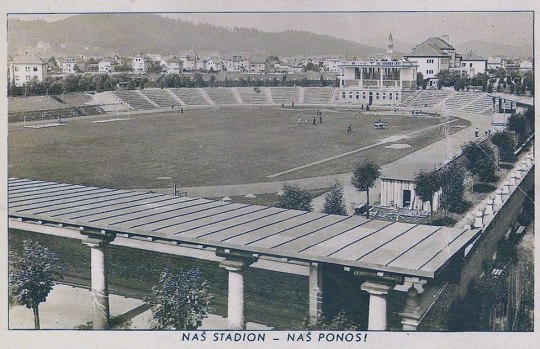
A consortium of public (the Municipality of Ljubljana and the Olympic Committee of Slovenia) and private partners (the businessman Joc Pečečnik and his company) has been promoting the project for more than a decade against strong and growing resistance from both professionals and the broader public. With 'Plečnik’s Ljubljana' a main tourist attraction and the state supporting its nomination for UNESCO World Heritage status, how could the destruction of one of his major works gain official support and approval? Whatever the final decision is about building or not building the stadium, we can say for certain that the investor has already scored at least one major victory: the stadium consortium’s financial and media muscle means that the destruction of one of the central works of the most famous Slovene architect is a realistic scenario.
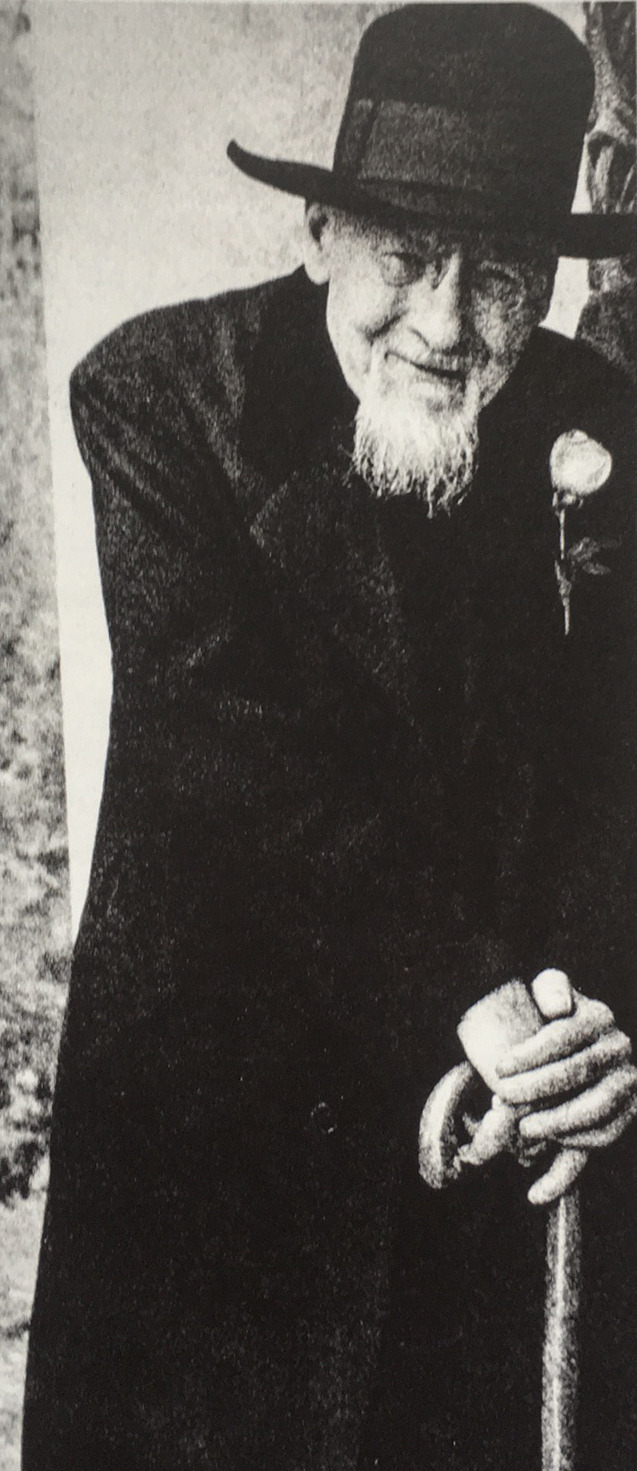
Plečnik on the Brioni Islands (1956). | Photo © Lojze Gostiša
Jože Plečnik (1872-1957) was a carpenter’s son, born in Ljubljana. In 1894, Otto Wagner, the most famous Viennese architect of the time, picked him out of a furniture design studio for his imagination and drawing skill. He soon became one of Wagner’s star pupils, and after graduation began to make his mark in the imperial capital with his avant-garde combination of modernism and classicism. A wider success followed soon after the end of the First World War, when Tomáš Masaryk, the president of the newly-created Czechoslovak republic, commissioned him to renovate the ancient Prague castle to become the official residence of the president.
At around the same time, Plečnik accepted the post of professor of architecture at the new University of Ljubljana, and began his gradual transformation of his provincial Austro-Hungarian hometown into the national capital of Slovenia. This was the beginning of Plečnik’s Ljubljana, as his idiosyncratic classicism changed both the physical fabric and the atmosphere of the city into a modern version of ancient Athens. In Plečnik’s scheme, the stadium by the main city avenue played a central role.

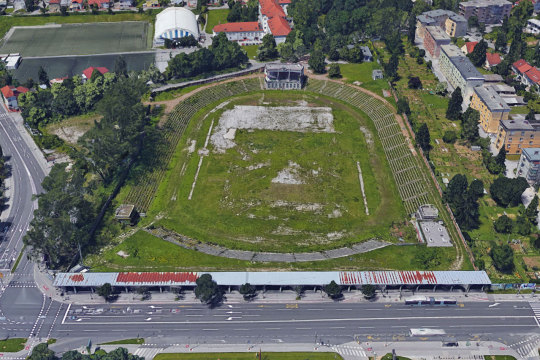
Construction of the stadium for the Roman Catholic youth sport association Orel began in 1925, but political and financial difficulties meant that it was not completed until 1935. | Photo via Outsider
The lengthy construction period and limited funds did not deter Plečnik, and one of his great strengths was his ability to improvise both materially and conceptually throughout the project.

The monumental colonnade created a civic stoa or covered walkway that links the stadium enclosure with the city beyond as well as prviding for a covered space for people to queue. | Photo © Peter Krečič
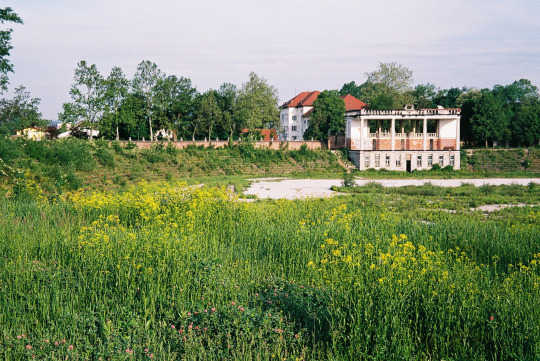
At the other end is the columned ‘Glorietta’, the stadium’s grandstand, which visually dominates the low complex, rising high above the visitors’ seats. | Photo via Failed architecture
For the most part, Plečnik made use of the existing terrain, so that architecture and landscape become an inseparable unity in his vision of the new space. The tree-lined avenues at the edges provide a visual accent of the enclosure, while the ingeniously-designed low brick walls divide the auditorium from the rest of the city, allowing a gradual transition from the wide and busy road on the one side to the low-level single-family houses with gardens on the other.
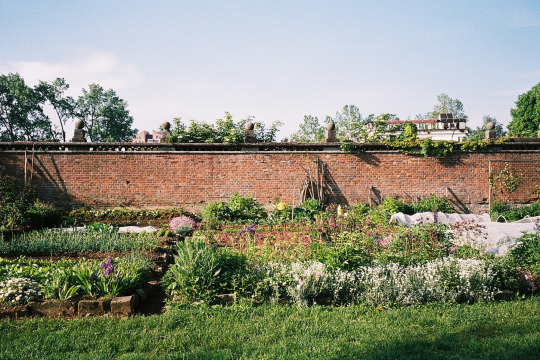
The communal gardens of the nearby Fond Blocks represent a sustainable and community-driven space at the northern edge of the complex, which has survived since the 1930s. | Photo via Failed architecture
The stadium became one of the central venues for landmark sport, music and political events in the history of the city and of the country. Later, it was converted into a football stadium, but its design and infrastructure were not ideal for this purpose. In 2010, a new football stadium was opened next to the the city motorway ring, and the old Plečnik stadium was closed.
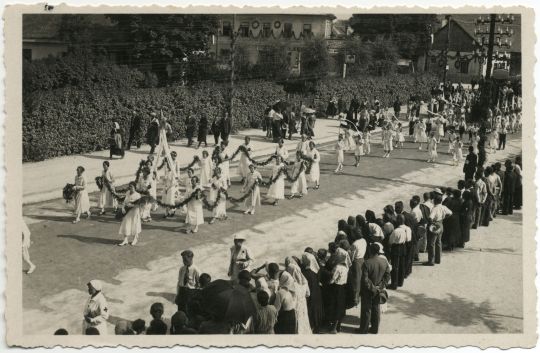

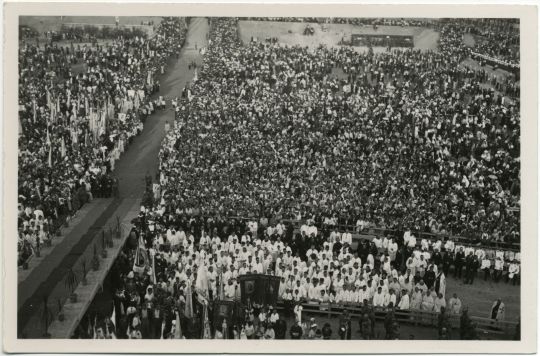
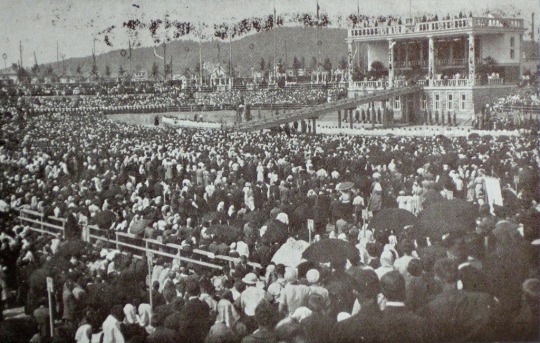
Different events during the history, also the first Eucharistic Congress in 1935 among them. | Photos via Nonument
It was at this point that the campaign for the radical reconstruction of the area began. In 2008 a public-private consortium led by Pečečnik and the Municipality called for an international competition, which was won by the GMP Architectural office from Berlin. The architects proposed extensive new construction to ‘optimise’ the commercial return on the extremely valuable plot. Almost all of the buildings would be torn down, with the site excavated to a depth of 22m and built up with basements of car parks and sport halls on five levels. Above the ground, a new stadium, with covered seating and VIP boxes on three levels, would be built, while around the outer edges of the new stadium, there would be an 18-storey skyscraper and three apartment blocks on the site of the communal gardens. Almost all of the Plečnik Stadium (except for the Glorietta and the colonnade) would have to be demolished.


The stadium in the 1950s and today, overgrown by vegetation. | Photo © Edi Šelhaus, Failed architecture
As a compromise, the investor has promised to rebuild the wall around the perimeter of the plot to the original plans and provide for the visitor stands where the old auditoriums were situated. Despite the almost total destruction of the stadium, the project has consistently been branded as the preservation of Plečnik’s legacy, reinforced by the fact that the stadium – now in the ownership of the stadium consortium – has been decaying ever since its closure. Redevelopment is, the investor claims, the only way to save the stadium, at an estimated cost of 240 million Euros while providing 800 new jobs.



Proposed reconstruction. | Rendering by GMP Architekten
Pressure from political and private interests has led to the project gaining widespread official approval, including that of the Heritage Protection Agency. This raised many eyebrows, as the Plečnik stadium was awarded the highest possible protection status of 'Heritage of National Importance' in 2010 (of course, the stadium is not part of the UNESCO nomination, because of its present status and uncertain future). The independent civic society and professional architectural, heritage and art-historical societies are all united in their opposition to the destructive plans. The international limelight was added to the redevelopment plans by the inclusion of the Stadium on the list of 7 most endangered European cultural heritage sites in 2020 by the NGO Europa Nostra. All of these organizations argue that redevelopment in this case means destruction only, with less than five per cent of the stadium preserved, while building up the whole of the plot would destroy not only the physical substance of Plečnik's masterpiece but also the spatial totality of the public, urban recreational facility the stadium has always been. Ljubljana's many unfinished construction sites raise further concern; economic uncertainty could mean that the consortium would have enough money to destroy a heritage site, but not to bring its plans to fruition. The new facility also seems unnecessarily ambitious, as a new stadium in Stožice meeting international standards is already built and operating well, and Ljubljana, a city of 300,000, has no need for two state-of-the-art football stadiums. The plans for the public part of the complex could be just a way of convincing stakeholders to sanction the destruction of heritage, with the end-product even less public and more commercial.
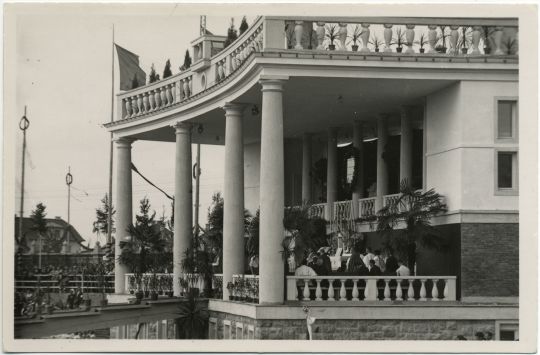
No one from the Municipality or the state will admit that the choice between the slow decay of the stadium and rapid destructive redevelopment is a false one. According to the esimates by the Ministry of Culture the third option, a faithful renovation of the complex as a civic recreation and sports park, would cost just around 3 million euros (1 per cent of the BSP project estimate). Such a low renovation estimate is possible because of a simple and economic conception of the original stadium, a consistent feature of Plečnik’s architecture in general. Ljubljana, a much richer and better-educated city than it was in 1935, seems to have lost the qualities of the great architect that gave it its shape.
-- Miloš Kosec
This article was first published in C20, the magazine of the C20 Society. See for more information or to join www.c20society.org.uk.
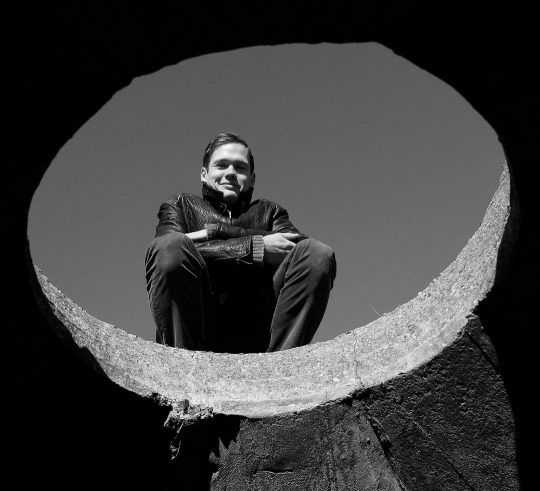
Photo © Stine Alling Jacobsen
Miloš Kosec is an architect, editor and publicist living and working in Ljubljana, Slovenia. He graduated from the Faculty of Architecture of Ljubljana University with the Master's thesis »Ruin as an Architectural Object«, which was published as a book in 2013. Miloš completed his PhD in 2019 at Birkbeck College, University of London, with a thesis »Passivism: Activism and Passivity in Contemporary Architecture«. He is researching, exhibiting, writing and publishing articles in professional and academic publications, focusing primarily on architecture, architectural history, political and social aspects of architectural design. Together with the Outsider magazine editorial board, he was one of the recipients of Plečnik medal for contributions to architectural culture in 2017. Miloš is also a practicing architect and landscape designer with a number of landscape realizations. In 2018, he was one of the authors of the Slovene pavilion at the Venice Architecture Biennial. He is a member of the editorial board of Outsider Magazine. He is also a member and a researcher of the international art and research project Nonument and is a frequent participant in international architecture conferences and events.
9 notes
·
View notes
Photo

The Philadelphia Enquirer. Philadelphia (PA). July 1976.
#grace kelly#princess grace#president ford#mrs joseph s rambo#gladwyne#cardinal krol#international eucharistic congress#philadelphia
4 notes
·
View notes
Text
Events 6.20
451 – Battle of Chalons: Flavius Aetius' battles Attila the Hun. After the battle, which was inconclusive, Attila retreats, causing the Romans to interpret it as a victory.
1180 – First Battle of Uji, starting the Genpei War in Japan.
1622 – The Battle of Höchst takes place during the Thirty Years' War.
1631 – The Sack of Baltimore: The Irish village of Baltimore is attacked by Barbary slave traders.
1652 – Tarhoncu Ahmed Pasha is appointed Grand Vizier of the Ottoman Empire.
1685 – Monmouth Rebellion: James Scott, 1st Duke of Monmouth declares himself King of England at Bridgwater.
1756 – A British garrison is imprisoned in the Black Hole of Calcutta.
1782 – The U.S. Congress adopts the Great Seal of the United States.
1787 – Oliver Ellsworth moves at the Federal Convention to call the government the 'United States'.
1789 – Deputies of the French Third Estate take the Tennis Court Oath.
1791 – King Louis XVI, disguised as a valet, and the French royal family attempt to flee Paris during the French Revolution.
1819 – The U.S. vessel SS Savannah arrives at Liverpool, United Kingdom. It is the first steam-propelled vessel to cross the Atlantic, although most of the journey is made under sail.
1837 – King William IV dies, and is succeeded by his niece, Victoria.
1840 – Samuel Morse receives the patent for the telegraph.
1862 – Barbu Catargiu, the Prime Minister of Romania, is assassinated.
1863 – American Civil War: West Virginia is admitted as the 35th U.S. state.
1877 – Alexander Graham Bell installs the world's first commercial telephone service in Hamilton, Ontario, Canada.
1893 – Lizzie Borden is acquitted of the murders of her father and stepmother.
1895 – The Kiel Canal, crossing the base of the Jutland peninsula and the busiest artificial waterway in the world, is officially opened.
1900 – Boxer Rebellion: The Imperial Chinese Army begins a 55-day siege of the Legation Quarter in Beijing, China.
1900 – Baron Eduard Toll, leader of the Russian Polar Expedition of 1900, departs Saint Petersburg in Russia on the explorer ship Zarya, never to return.
1921 – Workers of Buckingham and Carnatic Mills in the city of Chennai, India, begin a four-month strike.
1926 – The 28th International Eucharistic Congress begins in Chicago, with over 250,000 spectators attending the opening procession.
1942 – The Holocaust: Kazimierz Piechowski and three others, dressed as members of the SS-Totenkopfverbände, steal an SS staff car and escape from the Auschwitz concentration camp.
1943 – The Detroit race riot breaks out and continues for three more days.
1943 – World War II: The Royal Air Force launches Operation Bellicose, the first shuttle bombing raid of the war. Avro Lancaster bombers damage the V-2 rocket production facilities at the Zeppelin Works while en route to an air base in Algeria.
1944 – World War II: The Battle of the Philippine Sea concludes with a decisive U.S. naval victory. The lopsided naval air battle is also known as the "Great Marianas Turkey Shoot".
1944 – World War II: During the Continuation War, the Soviet Union demands unconditional surrender from Finland during the beginning of partially successful Vyborg–Petrozavodsk Offensive. The Finnish government refuses.
1944 – The experimental MW 18014 V-2 rocket reaches an altitude of 176 km, becoming the first man-made object to reach outer space.
1945 – The United States Secretary of State approves the transfer of Wernher von Braun and his team of Nazi rocket scientists to the U.S. under Operation Paperclip.
1948 – The Deutsche Mark is introduced in Western Allied-occupied Germany. The Soviet Military Administration in Germany responded by imposing the Berlin Blockade four days later.
1956 – A Venezuelan Super-Constellation crashes in the Atlantic Ocean off Asbury Park, New Jersey, killing 74 people.
1959 – A rare June hurricane strikes Canada's Gulf of St. Lawrence killing 35.
1960 – The Mali Federation gains independence from France (it later splits into Mali and Senegal).
1963 – Following the Cuban Missile Crisis, the Soviet Union and the United States sign an agreement to establish the so-called "red telephone" link between Washington, D.C. and Moscow.
1964 – A Curtiss C-46 Commando crashes in the Shengang District of Taiwan, killing 57 people.
1972 – Watergate scandal: An 18½-minute gap appears in the tape recording of the conversations between U.S. President Richard Nixon and his advisers regarding the recent arrests of his operatives while breaking into the Watergate complex.
1973 – Snipers fire upon left-wing Peronists in Buenos Aires, Argentina, in what is known as the Ezeiza massacre. At least 13 are killed and more than 300 are injured.
1973 – Aeroméxico Flight 229 crashes on approach to Licenciado Gustavo Díaz Ordaz International Airport, killing all 27 people on board.
1975 – The film Jaws is released in the United States, becoming the highest-grossing film of that time and starting the trend of films known as "summer blockbusters".
1979 – ABC News correspondent Bill Stewart is shot dead by a Nicaraguan National Guard soldier under the regime of Anastasio Somoza Debayle during the Nicaraguan Revolution. The murder is caught on tape and sparks an international outcry against the regime.
1982 – The International Conference on the Holocaust and Genocide opens in Tel Aviv, despite attempts by the Turkish government to cancel it, as it included presentations on the Armenian genocide.
1982 – The Argentine Corbeta Uruguay base on Southern Thule surrenders to Royal Marine commandos in the final action of the Falklands War.
1988 – Haitian President Leslie Manigat is ousted from power in a coup d'état led by Lieutenant general Henri Namphy.
1990 – Asteroid Eureka is discovered.
1990 – The 7.4 Mw Manjil–Rudbar earthquake affects northern Iran with a maximum Mercalli intensity of X (Extreme), killing 35,000–50,000, and injuring 60,000–105,000.
1991 – The German Bundestag votes to move seat of government from the former West German capital of Bonn to the present capital of Berlin.
1994 – The 1994 Imam Reza shrine bomb explosion in Iran leaves at least 25 dead and 70 to 300 injured.
2003 – The Wikimedia Foundation is founded in St. Petersburg, Florida.
2019 – Iran's Air Defense Forces shoot down an American surveillance drone over the Strait of Hormuz amid rising tensions between the two countries.
0 notes
Text
TIME OF THEIR LIVES: CTE holds 95th grad rites
To formally acknowledge the academic accomplishments of undergraduate and postgraduate educators, Cebu Normal University (CNU) held its 95th College of Teacher Education (CTE) Commencement Exercises at the International Eucharistic Congress (IEC) Pavilion, last May 28.
Centered on the theme “Embracing the Journey: Celebrating Growth, Resilience, and Achievement,” Magtutudlos proudly received…

View On WordPress
0 notes
Photo

23rd International Eucharistic Congress
Germany, 1912
St Anthony’s Guild cinderella stamp
USA
#Catholic#Sacred Heart#church#cathedral#Infant Jesus#St Anthony#Franciscan#religious#friar#cinderella stamp#Germany#saint#saints#Eucharist#Eucharistic Congress#1912#stamps#philately#USA#America#St Anthony's Guild
3 notes
·
View notes
Photo



WITTNESS OF HUNGARIAN HISTORY – HEROE’S SQUARE, BUDAPEST Heroes’ Square (or „Hősök tere” in Hungarian) is one of the most-visited attractions in Budapest, which was created in almost 30 years, starting towards the end of the 19th century. Widespread disbelief, that the Millenium Column and Millenium Monument of the square was built for the Millenium Celebrations of 1896. In fact, when the half-year long celebrations started, the square was almost empty. Only the present building of the Hall of Arts stood at the edge of the City Park, and in the middle of the spacious place one could see the Gloriett of Miklós Ybl. The Gloriett, erected in 1884 was a kind of „wellhouse”, marking the place, where Vilmos Zsigmondy’s drilling was completed in 1878 with finding the first hotspring of the Széchenyi (that time Artesian) bath. Today you see a memorial tablet to sign the notable place, within the fence of the Tomb of Unknown Soldier. On the place, where Millenium Monument stands today, in 1896 stood the main entrance to the Millenium Celebrations. The main highlight of Heroe’s Square is the Millennium Column, the focal point of the Millenium Monument. The statue of Archangel Gabriel and the seven Hungarian chieftains of the Hungarian tribes who, – according to our traditions – led by Árpád, conquered the area now known as Hungary was placed here in 1901. In the previous year the creation of György Zala won Grand Prix on the Paris World Exhibition. Behind the column is a semicircular colonnade with statues of famous men who made their mark on Hungarian history. Statues atop the colonnades symbolize War, Peace, Work and Welfare, and Knowledge and Glory. Though the monument was started to be designed already in 1896 (a parliamental act issued during the Millenium Celebrations ordered to mark all notable places of Hungary related to the Conquest), Albert Schickedanz and György Zala completed it only 35 years later. The square received its current name in 1932, three years after the completion of the Millenium Monument. When the monument was originally constructed, Hungary was part of the Austro-Hungarian Empire and thus the last five spaces for statues on the left of the colonnade were reserved for members of the ruling Habsburg dynasty. The Habsburg emperors were replaced with Hungarian freedom fighters when the monument was rebuilt after World War II. Since its creation Heroes’ Square has been the site of numerous special events. In 1919 – at the time of the first Communist dictature – the square’s statues were covered with red „mantle”. In 1938 the 34th International Eucharistic Congress was celebrated here. The square saw German and Soviet tanks, celebrations and demonstrations, feasts and processes. After WWII the square was place of many Socialist holiday celebrations staged during the country’s Communist era, first of all 1st May. In 1989 a crowd of 250,000 gathered at the square for the reburial of Imre Nagy, former Prime Minister of Hungary, leader of the Uprise of 1956, who was executed in 1958. Heroe’s Square is the first place even today, where official parade is effected on every national holiday. In 1991 Pope John Paul II celebrated holy mass on the square. The Heroe’s square gave place for almost 10 years to the „Connection” concerts – started with the free concert of Sting -, and since 2008 in every August to the final of the National Gallop. The Heroe’s Square is famous also for two museum. On one side of the square you can see the Museum of Fine Arts, and opposite to it th Hall of Arts.
4 notes
·
View notes
Text
Embracing the Catholic Faith
Embracing the Catholic Faith
2016 International Eucharistic Congress’ 51st celebration recorded an utmost amazement because of the countless Christian believers from all over the world gathered to be part of the most awaited occasion. It has always been a tradition for the congress to take place every after four years characterized by a life and faith and by the culture and tradition of a particular country. (more…)
View On WordPress
0 notes